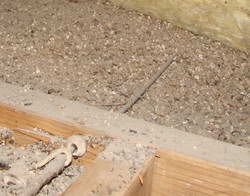|
» Home Electrical Wiring
» Electrical Wiring Directory
» Home Electrical Safety
» Need Electrical Help? Ask the Electrician
» Home Electrical Safety
» Need Electrical Help? Ask the Electrician
Avoiding Asbestos Contamination

|
Summary: A word of caution about asbestos-contamination and asbestos products, their removal, and the dangers of diseases like mesothelioma.
© By: Dave Rongey |
Asbestos May Be Present at Your Home Electrical Project Location
Today many people are taking on remodeling projects in their older homes to help increase their property values and bring electrical wiring up to local and national electrical codes.
Before you begin its a great idea to check out the possibility of any hazardous conditions including existing asbestos materials to avoid the possibility of asbestos-contamination.
Here I will be presenting a series of information as it pertains to attic insulation and paying close attention to a substance known as vermiculite.
| I have encountered the presence asbestos-contamination with vermiculite and will be sharing the concerns by way of government resources to help you avoid the possibility of coming into contact with a asbestos-contamination substance, which in many cases has been identified to contain asbestos, which could be a threat to your health and others in the remodel location. |
| It was bad enough that this home still had the old knob-and-tube-wiring, but to my surprise - under the fiberglass insulation was vermiculite insulation. | This vermiculite insulation was a granular looking substance which looks like it has expanded in size. |

|

|
The Safest Way to Test Electrical Devices and Identify Electric Wires!The Non-Contact Electrical TesterThis is a testing tool that I have had in my personal electrical tool pouch for years, and is the first test tool I grab to help identify electrical wiring. It is a Non-contact tester that I use to easily Detect Voltage in Cables, Cords, Circuit Breakers, Lighting Fixtures, Switches, Outlets and Wires. Simply insert the end of the tester into an outlet, lamp socket, or hold the end of the tester against the wire you wish to test. Very handy and easy to use.
The Quickest Way to Check for Faulty Electrical Wiring!The Plug-In Outlet TesterThis is the first tool I grab to troubleshoot a problem with outlet circuit wiring. This popular tester is also used by most inspectors to test for power and check the polarity of circuit wiring. It detects probable improper wiring conditions in standard 110-125 VAC outlets Provides 6 probable wiring conditions that are quick and easy to read for ultimate efficiency Lights indicate if wiring is correct and indicator light chart is included Tests standard 3-wire outlets UL Listed Light indicates if wiring is incorrect Very handy and easy to use.
Strip Off Wire Insulation without Nicking and Damaging the Electric Wire!The Wire Stripper and Wire CutterMy absolute favorite wire stripping tool that I have had in my personal electrical tool pouch for years, and this is the tool I use to safely strip electrical wires. This handy tool has multiple uses: The wire gauges are shown on the side of the tool so you know which slot to use for stripping insulation. The end of the tool can be used to grip and bend wire which is handy for attaching wire onto the screw terminals of switches and outlets.. The wire stripper will work on both solid and stranded wire. This tool is Very Handy and Easy to Use. |
||
Residential Electrical Parts and AccessoriesLight Switches 120volt Outlets Circuit Breakers Electrician Tools Voltage Testers |















